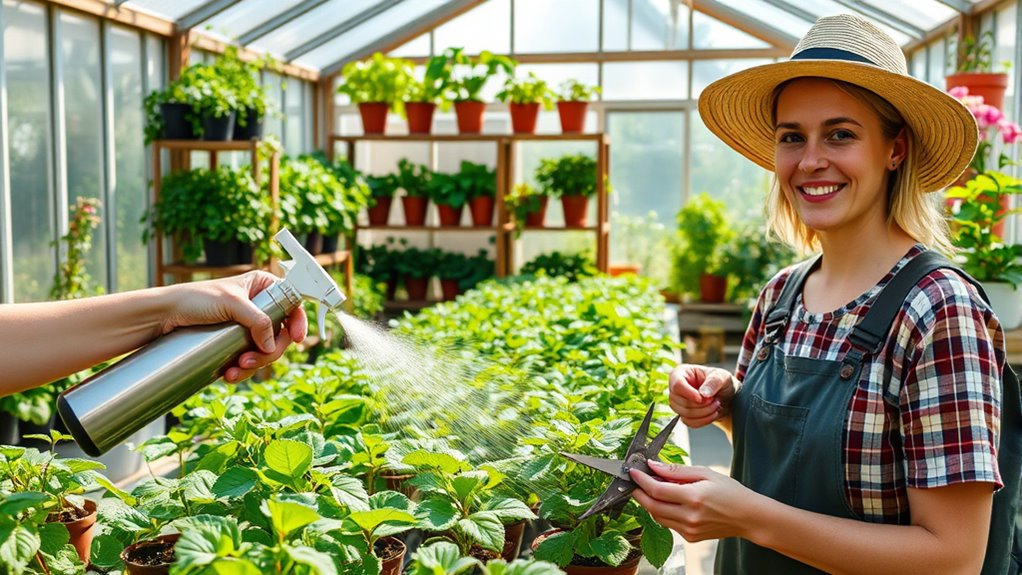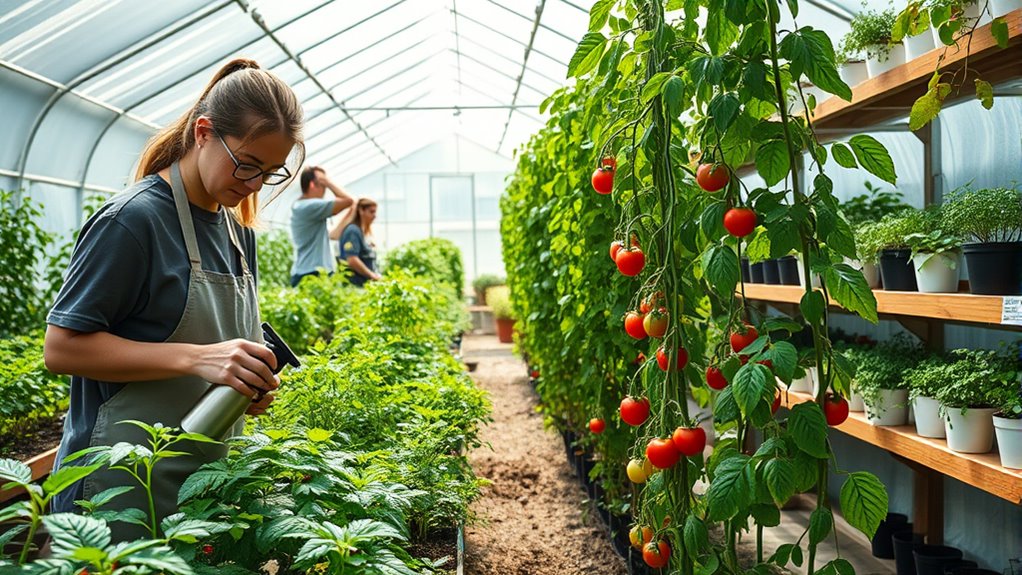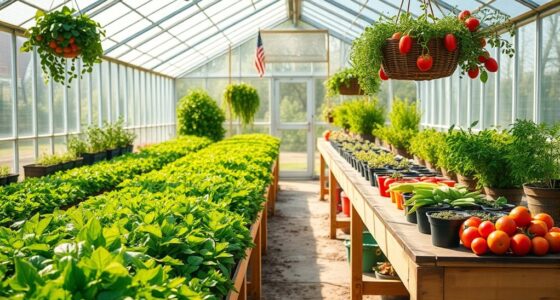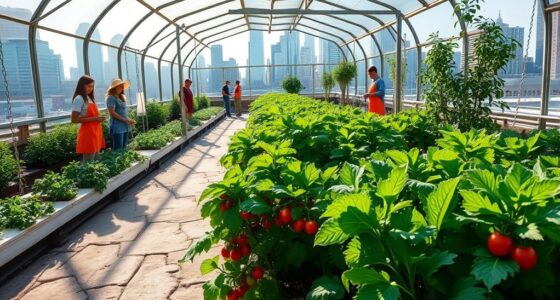As a volunteer, you make greenhouses thrive by helping design efficient layouts that maximize space and promote plant health. You monitor plants regularly for pests and apply natural pest control methods to keep everything balanced. Your daily care tasks like watering, pruning, and transplanting ensure healthy growth. By participating in planning and maintenance, you support a sustainable, productive environment. Keep going to discover even more ways your efforts foster a thriving greenhouse.
Key Takeaways
- Contributing innovative garden designs to optimize space and airflow.
- Assisting with watering, pruning, and transplanting to maintain plant health.
- Monitoring plants regularly for pests and applying natural control methods.
- Participating in strategic planning for sustainable and efficient growth.
- Supporting teamwork to ensure a productive, healthy, and inviting greenhouse environment.

Greenhouses rely on dedicated volunteers to stay productive and healthy, and your help can make a real difference. One key area where volunteers are invaluable is in garden design. Your fresh ideas and enthusiasm can help create a layout that maximizes space, improves airflow, and enhances plant health. When you assist with garden design, you’re not just arranging pots or beds; you’re shaping the environment where plants thrive. Thoughtful planning can reduce overcrowding, prevent disease spread, and make watering and maintenance more efficient. By contributing your perspective, you help develop a layout that encourages healthy growth and makes the greenhouse more inviting for visitors and staff alike. Additionally, volunteers often learn new skills in sustainable gardening practices, which further benefit the greenhouse’s overall health.
Another essential role volunteers play involves pest management. Pests can threaten the health of the entire greenhouse, so your active participation in pest control efforts is indispensable. This can include monitoring plants regularly for signs of pests, applying natural deterrents, or helping to implement integrated pest management strategies. Your involvement helps keep harmful insects at bay without relying solely on chemical solutions, which can harm beneficial insects and the environment. Consistent vigilance and early intervention are key, and your contribution ensures that pest management is a continuous process rather than a one-time task. Your eye for detail can catch potential problems before they escalate, saving time, money, and plants in the long run.
Beyond garden design and pest management, volunteers often assist with watering, pruning, and transplanting, but it’s the strategic planning that truly makes a difference. When you participate in designing the garden, you help establish a foundation for sustainable growth. Similarly, your active role in pest management protects this foundation by maintaining a healthy, balanced ecosystem inside the greenhouse. The combination of thoughtful garden design and diligent pest control creates a harmonious environment where plants can flourish. This teamwork ensures the greenhouse remains a productive space that can serve educational, research, or community purposes.
Your willingness to get involved in these specific roles demonstrates a commitment that benefits everyone. With your help in garden design, you contribute to a more organized, efficient, and aesthetically pleasing space. Through pest management, you help maintain the health and vitality of the plants, reducing the risk of disease and pest outbreaks. Every task you undertake, no matter how small it seems, plays a part in the bigger picture of keeping the greenhouse thriving. Your dedication not only supports the staff and the plants but also inspires others to appreciate the importance of volunteer involvement in maintaining a thriving greenhouse environment.
Frequently Asked Questions
How Do Volunteers Contribute to Greenhouse Plant Health?
You contribute to greenhouse plant health by engaging in plant propagation, helping to grow new plants from cuttings or seeds, which strengthens the greenhouse’s diversity. You also assist with pest management, identifying and removing pests to keep plants healthy and prevent infestations. Your active involvement guarantees crucial growing conditions, promotes plant vitality, and supports the overall success of the greenhouse’s ecosystem.
What Skills Are Needed for Greenhouse Volunteer Roles?
You’ll need a mix of skills like plant propagation and pest management to excel as a greenhouse volunteer. Your attention to detail helps you identify healthy plants and catch pests early. Basic knowledge of soil, watering, and pruning boosts your confidence, while patience and enthusiasm to learn keep you motivated. Unexpectedly, your ability to work with others fosters a collaborative environment, making every volunteer effort contribute to a thriving greenhouse.
How Can I Become a Greenhouse Volunteer?
You can become a greenhouse volunteer by seeking out local community engagement opportunities or contacting nearby greenhouses. Many organizations offer volunteer training, so you’ll learn essential skills for plant care and maintenance. Just sign up, attend training sessions, and show your enthusiasm. Your involvement helps the greenhouse thrive, and you’ll gain valuable experience while supporting your community. It’s a rewarding way to make a difference and connect with nature.
Are There Age Restrictions for Volunteering?
Age restrictions for volunteering vary, but many greenhouses welcome teen volunteers and encourage senior participation. You’ll often find programs tailored for different age groups, so teens can gain hands-on experience, and seniors can share their expertise. Check with your local greenhouse for specific age requirements, as they usually aim to create inclusive environments. Whether you’re a teen or a senior, there’s usually a way for you to get involved and help the greenhouse thrive.
What Safety Measures Are in Place for Volunteers?
Of course, safety isn’t optional here! You’ll find hazard prevention measures like gloves, goggles, and proper tools, plus clear emergency protocols to keep everyone safe. We make sure you’re prepared for any mishap, so you can focus on nurturing those plants, not worrying about slipping on a banana peel. Rest assured, your safety is our priority, and we’ve got it all covered, from hazard prevention to quick emergency responses.
Conclusion
Remember, many hands make light work, and your volunteer efforts can truly help a greenhouse flourish. Whether you’re watering plants, maintaining tools, or sharing knowledge, your contribution nurtures growth both inside and out. By pitching in, you’re not just helping plants thrive but also fostering a vibrant community. So keep in mind, a thriving greenhouse is like a well-tended garden—each small act adds up to something beautiful and bountiful.










